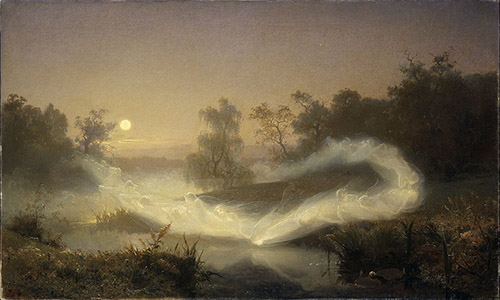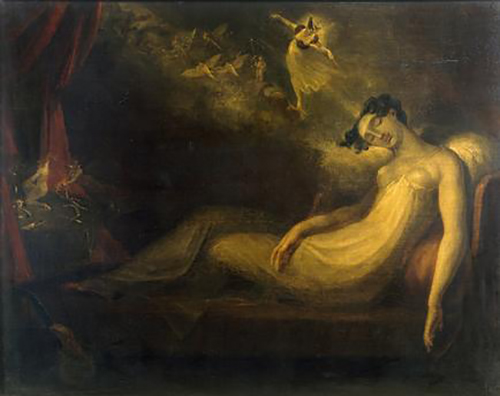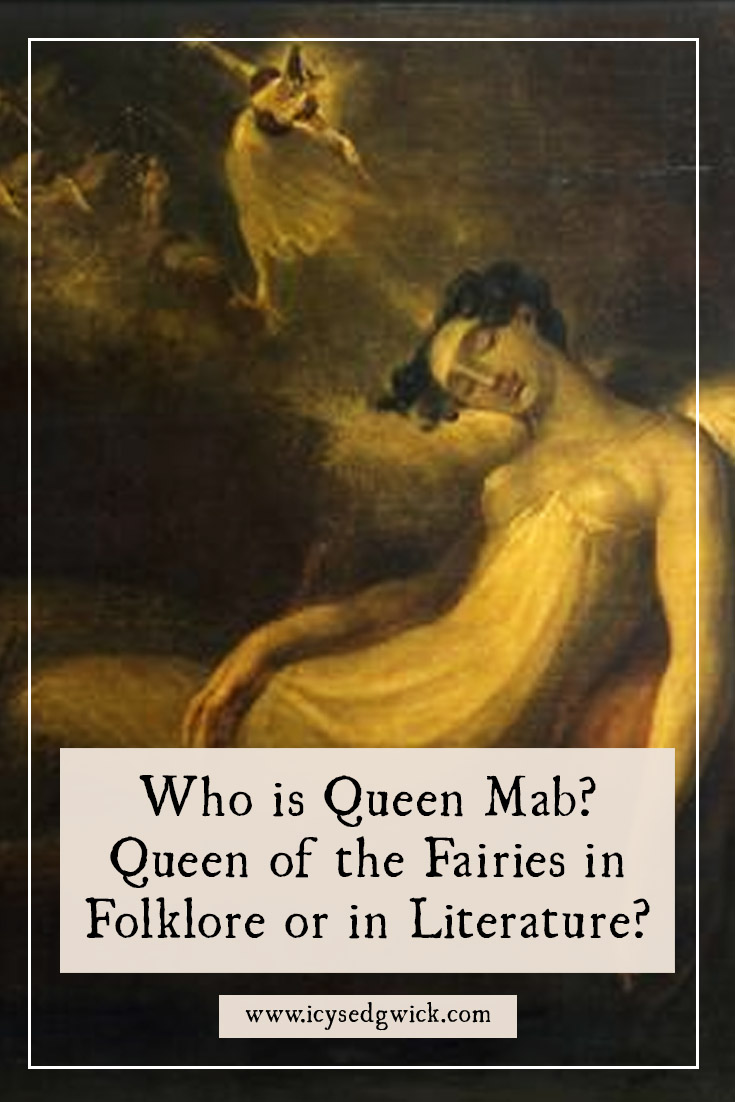The Queen of the Fairies is sometimes named Queen Mab, depending on the source material. She’s also known as the Queen of Elfland, the Queen of Elphame, and Titania.
So who is Mab? Does she come from English folklore, or is Mab the name given by playwrights and poets to the Queen in folklore?
Let’s find out more about Queen Mab!
Queen Mab, the Character
I should point out that this post focuses on English folklore due to Mab’s role in English literature. Scottish and Irish folklore also have their own distinct fairy monarchies, but they lie beyond this post. I recommend the work of Morgan Daimler if you want to learn more about them.
But on to Mab!
While we’re focusing on England in this post, it’s worth hopping over the border into Scotland for a moment. The Queen of the Fairies is not a new idea when Mab pops up in literature. She plays a central role in the legend of Thomas the Rhymer in the Borders. Musicologists have traced “The Ballad of Thomas the Rhymer” to the 13th century.
Here, she’s simply referred to as the Queen, giving us an established royal figure in the fairy world. She grants Thomas the gift of prophecy when he serves his 7-year term as her servant.
It is worth noting that the Queen of the Fairies also appeared during the Scottish Witch Trials. Alison Pearson claimed to be working for Queen of Elfhame, not the Devil, enlisted by the ghost of her dead cousin (Stewart 2021). She said she’d learned herbal medicine from the fairies. The Queen of Fairies was therefore linked with the diabolical, though she is not named as Mab.
So what about Mab?
Our best records for Queen Mab as a named figure come from literature, especially from the late 16th and 17th centuries, especially William Shakespeare.
The big question is, did Shakespeare give the Queen of the Fairies her name, or was he using an existing folk name? In some ways, I’m not sure it matters. It might be difficult to figure out which fairy lore comes from Shakespeare, and which fairy lore Shakespeare included. Who influenced whom?
For W. P. Reeves, he suspects that while Shakespeare had enough of an imagination to invent Mab’s name, “one can hardly escape the feeling that he borrowed the idea, and the name, as he did that of Titania” (1902: 11).
Mab’s Possible Origins
There’s a theory that Mab is a shortened version of Dame Abonde. She was part of the French fairy court in the Middle Ages. William of Auvergne, bishop of Paris, wrote that she led “nocturnal ladies”, who gifted abundance to houses they visited (Keightley 1870). It’s an incredibly tenuous link.
Another theory references Mab as a version of Mabh, described as an Irish fairy queen in Ancient Topography of Ireland by Beaufert (Reeves 1902: 11). Links to Medb, queen of Connaught, also fall apart since their nature seems so very different. Reeves even notes the difference in pronunciation, which again makes it unlikely the two are linked (1902: 12). Morgan Daimler also underscores the fact the two figures have no connection (2019).
A different theory took the Welsh ‘maban’ for ‘infant’. This theory assumed Mab made a good name for a tiny figure – even a queen (Reeves 1902: 11).
In Shakespeare
So onto Shakespeare, who really popularises Mab as a figure. He devotes a speech to her in Romeo & Juliet, first performed in 1597. Mercutio mentions her in a conversation with Romeo in Act 1, Scene 4, since he credits Mab with bringing Romeo his dreams. Here, Mab brings dreams appropriate to the dreamer. So lovers get dreams of love, courtiers dream of curtsies, lawyers “straight dream on fees”, soldiers dream “of cutting foreign throats”, and so on.
He also discusses her size, she is “no bigger than an agate stone”, and rides in an empty hazelnut as a chariot. If this all sounds very cute, fear not. Mercutio also accuses her of blistering ladies’ lips if their breath is tainted with sweetmeats. Yet her diminutive size stands at odds with the human size of Titania. Marjorie Swann notes that Shakespeare’s inability to represent Mab onstage shows how far she is from fairies in folklore (2000: 456).
At the end of his speech about Queen Mab, he also notes that she is “that very Mab/That plats the manes of horses in the night”. His assertion that she “bakes the elflocks in foul sluttish hairs,/Which once untangled much misfortune bodes” references the belief that fairies (or witches) would borrow horses during the night and ride them about the place. These braids in their mane were also known as witches’ knots, fairy knots, and elf locks (Neubert 2020). They were believed to be a sure sign your horse had been hag-ridden.
One way to avoid this was to hang a holed stone above your animals in their barn (Simpson 2003: 161). But Mercutio also notes the idea of Mab sitting on a dreaming woman, which again is a form of hagriding, notably captured by Fuseli as ‘The Nightmare’. Roger Lancelyn Green neatly draws the link between Mab as the bringer of dreams, and the creator of nightmares (1962: 95).
Strangely, he renames the Queen of the Fairies in A Midsummer Night’s Dream, where she becomes Titania. The plays were written in the same time period (1594 to 1596). Despite this, popular writers in the years after Shakespeare continued to name Mab as the queen (Reeves 1902: 10). Even as late as 1797, we find Queen Mab, or the Fairies Jubilee, composed for the marriage of Princess Charlotte.
Ben Jonson
Playwright Ben Jonson included Queen Mab as a major character in The Entertainment at Althorp, also known as A Particular Entertainment of the Queen and Prince. This was a masque performed in June 1603 specifically to welcome the Stuart royal family as they travelled from Edinburgh to London.
Mab appears in conversation with a satyr, and she is described in the stage directions as the queen of the fairies. Despite this apparent royal status, the satyr addresses her as “the Mistriss Fairy, That doth nightly rob the Dairy.” The satyr also reveals Mab’s ability to both help and hinder the churning of butter. He notes her harsh treatment of “Country Wenches”, pinching them if they don’t clean properly.
If that wasn’t enough, the satyr also reveals that Queen Mab steals babies and lead midwives astray into ponds and other watery places at night.

Interestingly, when Mab addresses Anne of Denmark at the end of the masque, she doesn’t refute any of the satyr’s assertions. Instead, she presents the queen with a jewel.
Yet isn’t it interesting that Jonson uses Mab, rather than Titania? He also follows what we would recognise from folklore as Mab’s attributes, compared to Mercutio’s casting of Mab as the bringer of dreams. It would be fascinating to know Jonson’s version points to a more widespread understanding of Mab and fairies in the popular imagination.
Poetry
Fairies appear in various poems by Robert Herrick in his Hesperides collection of 1648. Yet #556, ‘The Fairies’, explicitly resurrects Mab as a warning to women. He says;
“If we will with Mab find grace,
Herrick 1898 [1648]: 252
Set each platter in his place;
Rake the fire up, and get
Water in, ere sun be set.
Wash your pails, and cleanse your dairies;
Sluts are loathsome to the fairies;
Sweep your house, who doth not so,
Mab will pinch her by the toe”.
‘Sluts’ here refers to slovenly or lazy women, rather than sexually promiscuous women. That said, it’s still a horrid insult either way. The poem might be short but it’s to-the-point. Keep your house clean and tidy, and do all of your tasks, and you’ll enjoy Mab’s grace. Neglect your tasks and Mab will pinch your toe. We should note the poem is so short that we don’t know what her grace involves.
This refers to that comment by Jonson’s satyr that Queen Mab will pinch “Country Wenches” who don’t clean satisfactorily.
It puts me in mind of the brownies with their fixation on tidying messy houses and messing up tidy ones. Yet here, rather than presiding over such household drudgery, Mab is ensuring the housewife does the tasks, not any fairy inhabitants of the home. Her links with dreams seem all but forgotten.
Mab in Folklore
Mab does appear in folklore, though perhaps less often than we might assume. People seem to encounter fairies in a general sense, rather than fairy royalty. Though that’s not to say tales don’t exist in which Queen Mab does appear in all her glory.
People apparently once believed she lived in Fawdon Hill near Whittingham in Northumberland with her court. According to legend, fairies travelled from all over Britain to wait on Queen Mab at Fawdon Hill (Service 1834: 97).
In one legend, a farmer heard music coming from inside Fawdon Hill at midnight. When he got nearer, a door stood open in the hillside and he could see the fairy court enjoying a banquet. The fairies noticed him and sent a page out with a goblet. The farmer dashed the drink to the ground and rode home (Service 1834: 97). It certainly echoes Canon William of Newburgh’s similar tale from Willy Howe, except it names the fairy queen. Of course, we don’t know at what point anyone added Mab’s name to the story. Was it a common part of the legend in Whittingham, or did James Service add it to reference Shakespeare? Service’s retelling seems to be one of the earliest in print.

MA Richardson also cites Queen Mab and her court as being responsible for a series of circular basins in the rocks of the river bed by Rothley Mill, Northumberland, created for bathing purposes (1846: 325).
Other Legends
By 1849, being ‘Mab-led’ had become a term in Warwickshire that described being led astray by the will-o’-the-wisp (Brand 1849: 397). John Brand even makes a point that it’s pronounced ‘mob-led’. This certainly fits with the mischievous nature of Mab noted by Ben Jonson and Robert Herrick, while also linking to the malevolence of some of her actions.
Ethel Rudkin collected a tale from Broughton village in Lincolnshire, in which a depression near the west side of Ermine Street bore the name ‘Maude Hole’. According to legend, Empress Maude successfully hid in the hole, and people saw her ghost walking nearby every night at midnight. Yet Rudkin also noted that in one of the accounts given of the site, Queen Mab apparently walked in the area every night at midnight. It’s unclear as to why Mab did that unless someone confused Maude and Mab (1933: 212).
What happened to Queen Mab?
I don’t think Mab has ever fully gone away. While 19th-century literature introduced the fairy godmother to the fairy tale, both Mab and Titania continued to exist in the works in which they’d already appeared. As the vogue for fairies waned in folklore, replaced in some ways by ghosts, tales involve individual fairies rather than Mab.
Fiction largely seems to be Mab’s domain now. She appears in a range of modern fiction, including Jim Butcher’s The Dresden Files, and Miranda Richardson played her in the Channel 4 series about Merlin. In this retelling, Mab schemed to get Merlin into a position of power to bring the people back to the old ways. Without their belief in her, she would die.
And I can’t help thinking that her appearance in literature means that she’s more likely to live forever.
What do you make of Queen Mab? Did she come from folklore, or fiction?
References
Brand, John (1849), Observations on the popular antiquities of Great Britain : chiefly illustrating the origin of our vulgar and provincial customs, ceremonies, and superstitions, volume 3, London: Henry G. Bohn.
Daimler, Morgan (2019), ‘Irish-American Witchcraft: Medb Isn’t Mab And Other Truths’, The Agora, https://www.patheos.com/blogs/agora/2019/05/irish-american-witchcraft-medb-isnt-mab-and-other-truths/.
Green, Roger Lancelyn (1962), ‘Shakespeare and the Fairies’, Folklore, 73 (2), pp. 89–103.
Herrick, Robert (1898 [1648]), The Hesperides & Noble Numbers, edited by Alfred Pollard, volume 1, revised edition, London: Lawrence & Bullen.
Jonson, Ben (1603), ‘A Particular Entertainment of the Queen and Prince’, Holloway Pages, https://hollowaypages.com/jonson1692queen.htm.
Keightley, Thomas (1870), The Fairy Mythology: Illustrative of the Romance and Superstition of Various Countries, London: H. G. Bohn.
Neubert, Kelli (2020), ‘Witches’ Knots’, Western Horseman, https://westernhorseman.com/horsemanship/neu-perspectives/witches-knots/.
Reeves, W. P. (1902), ‘Shakespeare’s Queen Mab’, Modern Language Notes, 17 (1), pp. 10–14.
Richardson, MA (1846), The Borderer’s table book; or, Gatherings of the local history and romance of the English and Scottish Border, volume 5, London: Henry G. Bohn.
Rudkin, Ethel H. (1933), ‘Lincolnshire Folklore’, , 44 (2), pp. 189–214.
Service, James (1834), Metrical legends of Northumberland, Alnwick:W. Davison.
Shakespeare, William (1597), Romeo and Juliet from The Folger Shakespeare, Barbara Mowat, Paul Werstine, Michael Poston, and Rebecca Niles (eds). Folger Shakespeare Library, https://folger.edu/explore/shakespeares-works/romeo-and-juliet/.
Simpson, Jacqueline and Steve Roud (2003), A Dictionary of English Folklore, Oxford: Oxford University Press.
Stewart, Greg (2021), ‘Accused Witches of Fife: Alison Pearson’, Remembering the Accused Witches of Scotland, https://www.raws.scot/post/open-positions-for-research-assistants.
Swann, Marjorie (2000), ‘The Politics of Fairylore in Early Modern English Literature’, Renaissance Quarterly, 53 (2), pp. 449–73.
Nutty about folklore and want more?
Add your email below and get these posts in your inbox every week.
You'll also get my 5-step guide to protecting your home using folklore!








Have your say!